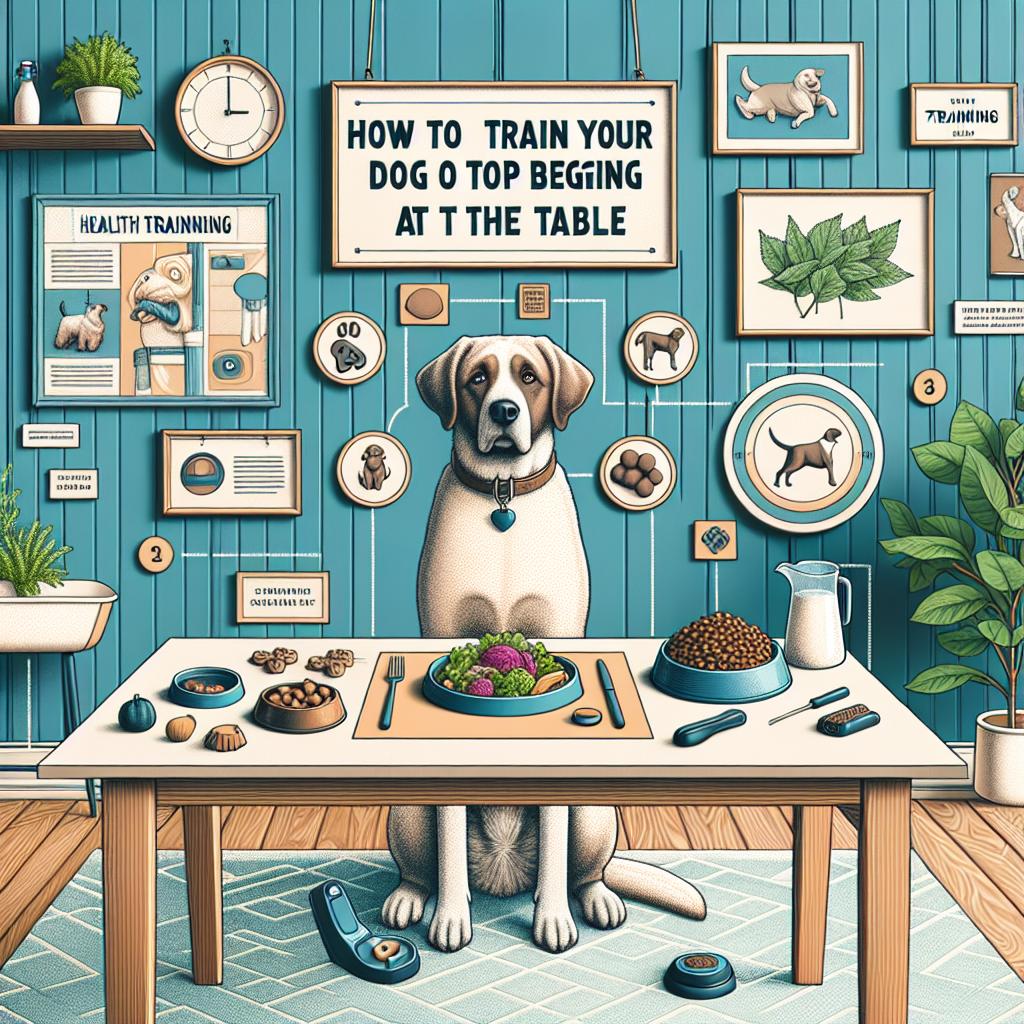Introduction
Mealtime should be a joyful occasion—a chance to gather around the table,share stories,and savor appetizing food. However, for many dog owners, this simple pleasure can be disrupted by a furry friend who has mastered the art of begging. With soulful eyes and an irresistible charm, dogs often make it challenging to enjoy a meal without feeling the tug of guilt or the constant distraction of a hopeful snout hovering near our plates. But fear not! With a little patience, consistency, and the right techniques, you can teach your dog to respect mealtime boundaries while still feeling loved and included. In this article, we’ll explore effective strategies to curb begging behaviour, ensuring that both you and your four-legged companion can enjoy meal times in harmony. Let’s embark on this training journey together,transforming your dining experiance from chaos to calm.
Understanding the psychology Behind Your Dogs Begging Behavior
Dogs are not only our companions but also astute observers of human behavior. Their begging at the table frequently enough stems from a combination of natural instinct and environmental conditioning. For many dogs, begging is a learned behavior that begins in puppyhood, were they observe their owners eating and quickly associate the act with potential rewards. They quickly learn that their adorable expressions or persistent nudges elicit attention, and more importantly, food. This behavior can be reinforced whenever food is dropped or shared, leading dogs to believe that their persistent begging translates into a meal.
Understanding this behavior can be crucial in retraining your canine companion.The key lies in consistency and establishing a structured routine. Here are some strategies to keep in mind:
- Set specific meal times for your dog.
- Always feed them before you sit down to eat.
- Use positive reinforcement to reward them for staying calm and settled during your meals.
- Avoid giving in to their pleading looks, as this reinforces the behavior.
By understanding their psychology, you can successfully guide your dog to develop better habits and help them learn that begging isn’t the way to a tasty treat!
Establishing Clear Boundaries and Consistent Rules
Creating a peaceful dining habitat for you and your dog starts with establishing clear boundaries. Consistency is key when reinforcing these rules, so it’s essential that every member of the household is on the same page. Begin by determining specific spots for your dog during meals, such as a designated mat or bed located away from the dining table. This can help your dog understand where they are allowed to be during mealtime. Additionally, develop a set of simple commands that everyone can use, such as “place” or “stay,” to redirect your dog when they attempt to beg for food.
once boundaries are established, applying consistent rules will help reinforce the message. Reward your dog for adhering to these boundaries without distractions. You can use treats,verbal praise,or petting to acknowledge their good behavior when they remain in their designated spot. If they wander too close, calmly guide them back with a firm, yet gentle, reminder of the rules.It may also be helpful to track your progress, noting instances of success versus setbacks in a simple table:
| Day | Triumphant Boundaries | Setbacks |
|---|---|---|
| Day 1 | 8 | 2 |
| Day 2 | 10 | 1 |
| Day 3 | 9 | 3 |

Engaging Alternative Training Techniques to Redirect Attention
To redirect your dog’s attention away from the dining table, you can incorporate engaging alternative training techniques that are both effective and enjoyable for your canine companion. One such method involves teaching your dog a fun trick or command that requires concentration and focus. For example,consider practicing “sit”,“stay”,or even “spin” whenever you’re about to eat. This not only keeps your dog occupied but also reinforces their ability to follow commands. To enhance this training, use positive reinforcement by offering treats or praise when your dog successfully obeys the command.
Additionally, creating a designated space for your dog during mealtime can dramatically reduce begging behavior. Here are a few strategies to consider:
- Use a crate or bed: Invite your dog to relax in their crate or a specific spot in the room with a comfy bed or blanket.
- Interactive toys: Provide engaging toys that dispense treats, keeping their attention focused elsewhere.
- Scheduled feeding times: Feed your dog before family meals to ensure they are full and less tempted to beg.
These techniques not only help manage your dog’s behaviors during meals but also stimulate their mind, creating a more balanced and happy pet.

Rewarding Positive Behavior for Long-Term Success
One effective method to cultivate long-lasting positive behavior in your dog is to reward them immediately when they choose to behave appropriately, especially around the dinner table. This could mean rewarding them with verbal praise, cuddles, or even treats when they remain in their designated spot rather of begging. Consistency is key; make sure everyone in your household is on the same page regarding these rewards. By reinforcing the right behavior, your dog learns that staying calm and quiet is far more rewarding than begging.
In addition to direct rewards, consider implementing a structured routine that helps your dog understand when it’s appropriate to be involved during meal times. Such as,you can establish a designated “quiet time” on a mat or bed during family meals. Every time they stay put, offer them a small reward from a reward jar that you refilled regularly.over time, this tangible association with positive behavior will make it clear to your dog that good behavior leads to good things, fostering a more peaceful dining experience for everyone.
Q&A
Q&A: How to Train Your Dog to Stop Begging at the Table
Q: Why does my dog beg at the table?
A: Dogs are natural scavengers and have a keen sense of smell, making them easily tempted by the aroma of human food. Additionally, begging can be reinforced by past experiences where they received food scraps or attention when they approached the table.
Q: What are the consequences of letting my dog beg?
A: Allowing your dog to beg at the table can promote undesirable behaviors such as constant pawing, whining, or even stealing food. This can lead to obesity and other health issues in your dog, alongside negatively impacting your dining experience.Q: What’s the first step to stopping this begging behavior?
A: The first step is to establish rules and be consistent.Decide whether the dog is allowed in the dining area or not and stick to that rule without exception. Consistency is key to helping your dog understand what’s expected.
Q: Can I just scold my dog to stop begging?
A: Scolding alone is frequently enough ineffective and can create anxiety.Instead, focus on training your dog with positive reinforcement. Reward them when they remain calm and seated away from the table, rather than punishing them for begging.
Q: How can I redirect my dog’s attention during meals?
A: Use a designated spot like a mat or dog bed where your dog can relax during mealtime.Teach your dog to go to this place using commands and reward them with treats.The goal is to create a positive association with their designated spot.
Q: Is it helpful to provide my dog with a meal or treat before I eat?
A: Absolutely! Giving your dog a meal or a chew toy before your mealtime can keep them occupied and satisfied, reducing the chances of them begging for your food. It also creates a routine that helps minimize their attention-seeking behavior.
Q: How long will it take for my dog to stop begging?
A: Every dog is different, and the time it takes to curb begging behavior can vary based on their temperament, age, and prior experiences. With consistent training and positive reinforcement, you may start to see improvements within a few weeks.
Q: What if my dog continues to beg despite my efforts?
A: If you encounter persistent begging, consider seeking advice from a professional dog trainer or a behaviorist.They can provide customized strategies tailored to your dog’s specific needs and behaviors to help you further navigate this challenge.Q: Can some dog breeds be more prone to begging?
A: Yes, certain breeds, especially those with strong food drive like beagles or Labrador retrievers, may be more inclined to beg due to their nature. Understanding your dog’s breed characteristics can definitely help in finding tailored strategies to reduce this behavior.
Q: What’s the ultimate goal of training my dog to stop begging?
A: The ultimate goal is to foster a peaceful dining environment for both you and your dog. By training them to refrain from begging, you’re not only addressing a behavior issue but also enhancing their overall well-being and helping them learn boundaries in a loving and respectful manner.
with patience and consistency, you can train your furry friend to leave their begging days behind!
Final Thoughts
training your dog to stop begging at the table is a journey that requires patience, consistency, and a little bit of creativity. By understanding your pet’s behavior and applying the techniques outlined in this guide, you can foster a more peaceful dining experience for both you and your furry friend. Remember, it’s not just about eliminating unwanted behavior; it’s about building a stronger bond through interaction and mutual respect. With time and dedication, your dog can learn that the dining table is a no-beg zone, allowing you to enjoy your meals in harmony. So grab those training treats, find a comfy spot, and embark on this rewarding path together—your mealtime experience awaits a refreshing change!

